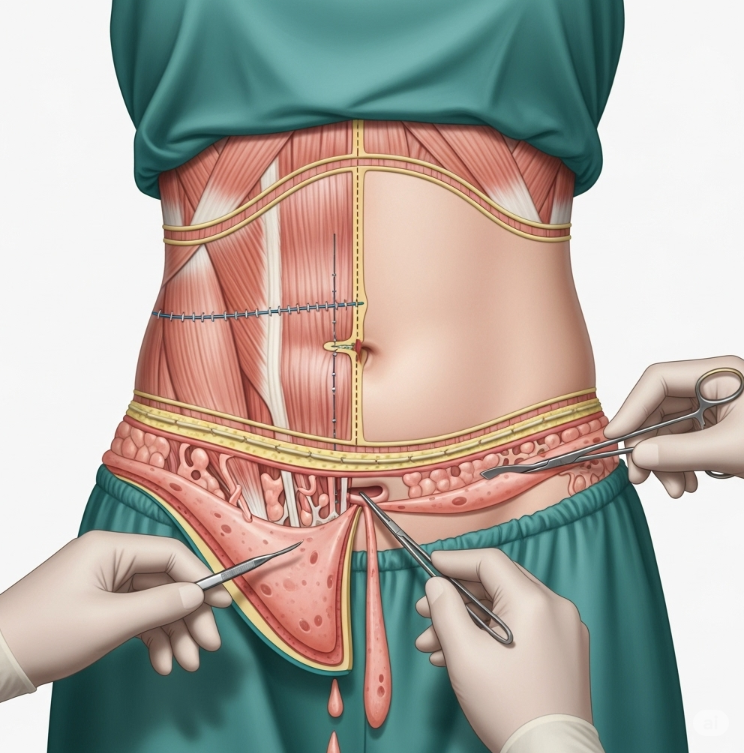Treatment Overview
Abdominoplasty in Korea, commonly known as a tummy tuck, is a cosmetic surgical procedure that removes excess skin and fat from the abdominal area while tightening weakened or separated abdominal muscles. It is one of the most effective treatments for patients who want a flatter, firmer, and more toned midsection, especially after pregnancy, weight loss, or aging.
Korean plastic surgeons are highly regarded for their expertise in body contouring and scar-minimized techniques. Many clinics also combine abdominoplasty with liposuction for comprehensive body reshaping, ensuring smooth contours and an improved waistline.
Purpose & Benefits
- Flatter Abdomen: Removes loose skin and excess fat.
- Tightened Muscles: Repairs stretched or separated abdominal muscles (diastasis recti).
- Improved Waistline: Creates a slimmer, more youthful midsection.
- Removes Stretch Marks: Especially those located on lower abdomen skin that is excised.
- Boost in Confidence: Improves clothing fit and self-image.
- Long-Term Results: When paired with a stable lifestyle, results last many years.
Ideal Candidates
- Men or women with loose or sagging abdominal skin.
- Patients with excess skin and fat after weight loss or pregnancy.
- Individuals with weakened or separated abdominal muscles.
- Adults in good health with stable weight.
- Non-smokers with realistic expectations.
- Those who have not achieved desired results through exercise or diet alone.
Possible Risks & Complications
- Temporary swelling, bruising, and abdominal discomfort.
- Scarring (though usually hidden below the bikini line).
- Fluid buildup (seroma).
- Infection or delayed wound healing (rare with proper care).
- Numbness or changes in skin sensation.
- Blood clots (minimized with proper aftercare and mobility).
Surgical Techniques Used
- Full Abdominoplasty: Removes excess skin and tightens muscles across the entire abdomen.
- Mini Abdominoplasty: Focused only on the lower abdomen, with a shorter scar and faster recovery.
- Extended Abdominoplasty: Addresses abdomen, flanks, and lower back for larger body contouring.
- Lipo-Abdominoplasty: Combines tummy tuck with liposuction for enhanced sculpting.
- High Tension Suturing: Creates smoother skin re-draping and minimizes sagging.
Recovery & Aftercare
- 1–2 weeks: Bruising, swelling, and tightness gradually improve.
- Compression garment worn for 4–6 weeks to reduce swelling and support healing.
- 1–2 weeks: Return to office work and light activity.
- 4–6 weeks: Resume exercise and heavy lifting.
- 3–6 months: Final results visible as swelling subsides and scars mature.
Aftercare Guidelines:
- Sleep with torso slightly elevated for the first 1–2 weeks.
- Avoid strenuous activity early in recovery.
- Attend follow-up visits for wound and scar monitoring.
Results & Longevity
- Flatter, tighter, and more youthful abdomen.
- Improved posture and comfort due to stronger abdominal wall.
- Permanent removal of excess skin and fat.
- Long-lasting results, especially with stable weight and healthy lifestyle.
- Scars fade significantly over time with proper care.
Treatment Process in Korea
1. Initial Consultation & Assessment
- Surgeons assess abdominal skin, muscle tone, and fat deposits.
- Decision made between mini, full, or extended abdominoplasty.
2. Surgical Planning & Preparation
- Marking incision sites (usually below bikini line).
- Choice of anesthesia: general anesthesia most common.
3. Surgery Day
- Incision made across lower abdomen.
- Excess fat and skin removed.
- Abdominal muscles tightened with sutures.
- Skin re-draped and belly button repositioned if necessary.
4. Post-Operative Monitoring
- Compression garment applied immediately.
- Hospital stay: same-day discharge for mini tummy tuck; 1–2 nights for full abdominoplasty.
- Aftercare instructions provided.
5. Follow-Up & Refinement
- Follow-up visits at 1 week, 1 month, and 3–6 months.
- Optional scar care treatments (laser or creams) to minimize visibility.
Why Korea is a Top Destination
- Surgeons with expertise in scar-minimized tummy tucks.
- Advanced techniques for natural waistline contouring.
- Use of liposuction-assisted abdominoplasty for smoother results.
- State-of-the-art clinics with international patient support.
- More affordable pricing compared to Western countries, with equally high standards.
Cost Range
The cost of Abdominoplasty in Korea varies depending on the extent of correction, type of tummy tuck, and clinic reputation.
- Mini Abdominoplasty: USD $4,000 – $6,000
- Full Abdominoplasty: USD $6,000 – $9,000
- Extended Abdominoplasty: USD $8,500 – $12,000
- Lipo-Abdominoplasty (Tummy Tuck + Liposuction): USD $9,000 – $13,000
- Premium Clinics (3D Imaging, VIP Aftercare, Scar Management): USD $10,000 – $15,000
Additional Costs:
- Consultation & imaging: USD $100 – $300
- Compression garment: USD $50 – $200
- Medications & aftercare: USD $100 – $200
Popular Clinics
- Banobagi Plastic Surgery (Seoul): Specialists in tummy tuck + liposuction contouring.
- ID Hospital (Seoul): Known for extended abdominoplasty and post-weight loss body contouring.
- JK Plastic Surgery Center (Seoul): JCI-accredited, focusing on scar-minimized tummy tucks.
- View Plastic Surgery Clinic (Seoul): Experts in mini abdominoplasty with quick recovery.
- JW Plastic Surgery (Seoul): Experienced in full and lipo-abdominoplasty procedures.




